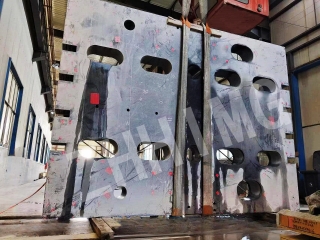Granite assembly is a technology used in the manufacturing of optical waveguide positioning devices. It involves the use of granite, which is a natural stone that is highly durable, to create a stable and precise base on which the optical waveguide positioning device can be constructed. The advantages of granite assembly for optical waveguide positioning devices are numerous, but there are also some disadvantages to consider.
Advantages:
1. Stability: Granite is highly stable and does not move or shift, making it an ideal material for creating a base for optical waveguide positioning devices. This stability ensures that the device remains accurate and precise even during long-term use.
2. Accuracy: Granite is highly accurate due to its low coefficient of thermal expansion. This means that the dimensions of the granite remain constant even under varying temperatures. As a result, optical waveguide positioning devices that use granite assemblies are very accurate.
3. Durability: Granite has excellent wear resistance and can withstand exposure to harsh environments, including extreme temperatures, corrosive chemicals, and constant vibration. This durability ensures that the device lasts longer and requires fewer repairs or replacements.
4. Cost-effective: Granite is an affordable material, making it a cost-effective option for manufacturing optical waveguide positioning devices. Additionally, the long lifespan of the device ensures that it provides good value for money.
5. Aesthetics: Granite's natural beauty and various color options make it an attractive material for optical waveguide positioning devices. The devices look professional and enhance the work environment's aesthetic appeal.
Disadvantages:
1. Weight: Granite is incredibly dense and heavy, which means that optical waveguide positioning devices constructed with granite assemblies can be heavy and difficult to move. This can be challenging when moving the device from one location to another.
2. Manufacturing: Granite requires specialized machinery to cut and shape it, making it a more time-consuming and labor-intensive process than other materials.
3. Installation: The installation process for granite assembly devices can be time-consuming and requires skilled technicians.
4. Maintenance: While granite is durable, it does require regular maintenance to keep its appearance and function. Without proper care, the device's surface can become scratched, and its accuracy may decrease.
5. Brittle: While granite is durable and wear-resistant, it is also brittle, which means that it can crack or chip if exposed to excessive force or pressure. Careful handling is necessary during assembly, transport, and installation.
While there are some disadvantages to using granite assembly in optical waveguide positioning devices, the advantages far outweigh the drawbacks. Overall, granite is an excellent material for optical waveguide positioning devices due to its stability, accuracy, durability, cost-effectiveness, and aesthetic appeal. By weighing the pros and cons of granite assembly, manufacturers can make informed decisions and produce high-quality devices that meet customers' needs and expectations.
Post time: Dec-04-2023

